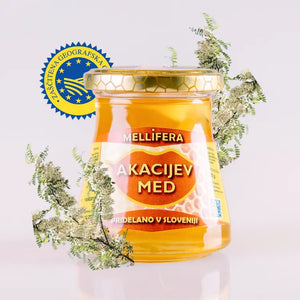
Winter is a very special time for bees, when their life rhythm changes significantly. While in the warm months we find them in meadows and gardens, diligently collecting honey and pollinating flowers, autumn begins their preparation for the colder months. Let's see how bees ensure their survival during the time when nature is at rest.
1. Preparing food supplies
During the summer, bees collect large quantities of nectar and pollen, which they process in the hive into honey and perga. These bee products are their main source of food throughout the winter. Honey contains a high proportion of sugar, which provides the bees with energy to heat the hive, while perga provides the workers with necessary nutrients.
Beekeepers who take care of the hives leave enough honey for the bees to survive the winter. Only in this way can the bees enter the winter period with enough energy.
2. Winter cluster: bee heater
During the cold months, bees form a special "winter cluster." This is a tightly packed group of bees that use their body heat to help maintain a suitable temperature inside the hive.
-
How it works: The bees in the center of the cluster move and generate heat, while those on the periphery act as insulation. To prevent hypothermia, the bees alternate between inner and outer layers in a systematic manner.
-
Temperature in the hive: The winter cluster maintains a temperature of 20°C to 35°C, depending on the location in the cluster.
3. Transition to less activity
During the winter, bees do not undertake major tasks, as their main priority is to conserve heat and energy. Bees do not leave the hive except on very rare occasions when it is a few degrees above freezing outside and they make a short "cleaning flight" to remove waste from the hive.
The hive also does not produce brood (young bees) during the winter, as caring for the brood would use up too much energy and food. This process begins again in early spring.
4. Winter traps for bees
The winter season can be challenging for bees. The main threats they face are:
-
Lack of food: If the beekeeper does not leave enough honey in the hive or if supplies are not evenly distributed, the bees may starve.
-
Humidity in the hive: Excessive humidity can cause disease and reduce bee resistance.
-
Frost: Severe winters can weaken a hive, especially if the bees cannot maintain the proper temperature in the cluster.
-
Varroa: This parasite is one of the main enemies of bees, which can weaken the hive just before winter.
5. How can we help bees?
Each of us can contribute to making bees' survival easier by:
-
We plant honey plants such as lavender, sunflowers, and buckwheat so that bees have enough food during the season.
-
We do not use pesticides in our garden that are toxic to bees.
-
We support local beekeepers by purchasing honey and other bee products.
Conclusion
Winter is a period of survival for bees, in which they rely on their organization, food supplies and environmental support. When you open a jar of honey in winter, remember how much effort and work bees have put in to make this sweet gift of nature possible for us.
May the winter pass peacefully and safely for the bees, so that they can delight us again in the blooming meadows in spring! 🌼🐝
Do you want the real thing?
How can you find real unheated Slovenian honey?
We ensure that our honeys retain their natural potency, as we have a line that is never heated. This ensures that they are full of flavor and nutrients – just as the bees create them.
Check here 👉🏻 https://mellifera.si/collections/nesegreti-med



